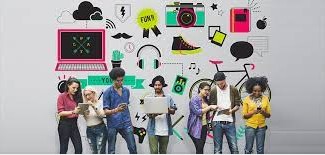
Our views of what it should look like and how it should materialize depend on our value of it and our experience with it.
What if a class consisted of words that led to information that whirled into blended realms of creativity set up just for students, created by students? The students then dictated what they learned instead of reluctantly ingesting information and standards imposed upon them.
That exists here and now. In every nook and cranny, around every corner, inside every well-engineered lesson, students might just learn what they want to learn and actually find success while improving the world around them.
Take a tour of 50 different views of education that somehow find a similar note: Education is changing and there may certain things every classroom should have.
Modern Trends In Education: 50 Different Approaches To Learning:-
1. Ground Up Diversity
The late Sir Ken Robinson campaigned for changing education through talks, writing, advising, and teaching. He believes education must change because it’s a stale environment in which most students don’t really learn what they should or want to learn. How that happens makes all the difference—from the ground up. People, students, and teachers create the change, not the administrators or the executives.
2. Social Networking
With social networking growing to the point that Technorati last tracked about 70 million updated blogs, using social networking to teach any subject and catapult students into a realm other than stagnant learning means blending the traditional education with modern communication. Many educators believe this is the route to engaging students in learning all the basic skills they need.
3. Competency-Based Learning
Competency-based learning is an approach to education that focuses on the student’s demonstration of desired learning outcomes.
4. Underground Education
According to John Taylor Gatto, teachers should choose the real world over the classroom. Students don’t learn to live or survive in a classroom. They learn to survive in the real world so the concept of underground education challenges educators in any walk of life to give students the tools with which to live and breathe in the world around them. If the lesson must be taught, then teach it thinking of who they might become.
5. Navdanya
Dr. Vadana Shiva’s mission lives and breathes in Navdanya, an organization that promotes self-reliance and earth democracy. The leaders of the organization are women who find strength in women’s movements and give women a voice. Earth democracy developed from the idea of seed saving helping local communities become self-reliant.
6. Self-Directed Learning
Read here for more on Self-Directed Learning.
7. Social Status
Even more significant to learning than being an asset, social status plays an underlying role in the education of a small or large group of people whether it’s an entire country’s agenda or certain sections or communities within that country. In other words, if that community puts importance on education as a social benefit, students and people in that community will strive to achieve it in order to raise their status in the community.
8. Lesson Study
Originating in Japan, lesson study applies to style of teaching. Conceptually, lesson study promotes the idea that teachers constantly improve and change their style of teaching based on students’ performance and reaction to it. It sounds like what we already do but not exactly. Collaboration between teachers is paramount and so is change. Combining these two factors with constant change means students never stop learning.
9. Constructive Struggling
Another Japanese form of teaching is to allow students to struggle through a lesson with guidance from their teacher. In other words, the student shouldn’t be embarrassed about failing the first time around, not even the second or third time. The instructor should actually encourage students to learn from that failure.
10. School in the Clouds
After experimenting with a computer in a wall where poor children basically found a way to learn without a teacher, Sugata Mitra won the Ted Prize of $1 million in 2013. He wrote an ebook named Beyond the Hole in the Wall offering an ideal for education based on a very real premise that students learn no matter what social status or economic background. They simply need the tools with which to do so.
11. Problem-Based Learning
In regards to tertiary education, problem-based learning is gaining popularity in Australia. Students are given a real-world problem then they work together to find a solution to this. In Australia, nursing programs have begun to embrace this style of teaching and learning because it challenges the students to work as if they’re dealing with real problems they’ll encounter in the workplace. Teachers find it invaluable because students learn more with this method.
12. Learning with Technologies
Another view found around the world surrounds the use of technologies as a key to students improving their learning and ‘marketability.’ Within the realm of technologies, teachers encourage students to innovate, bringing them full-circle into the 21st-century where visibility and adaptability rule.
13. Constructivist Learning
According to Dimitrios Thanasoulas of Greece with relation to philosopher Giambattista Vico, humans only understand what they construct. This concept runs on the idea that students create their own learning environments, actively participating in the knowledge they ingest. Creating your own learning involves making mistakes with no preset agenda in place. Constructive learning is not stable so many educational systems reject it.
14. International Objectives
Many countries are creating a climate conducive to international students’ interests and desires. In 2010, $7.7 billion was spent on tuition by international students in Canada. Countries that give attention to international students find economic benefits in both education and employment.
15. Asynchronous Learning Hubs
Whether through videos, cohorts, online courses, playlists, live streaming, or other approaches, the future of learning will likely be at least partly asynchronous.










